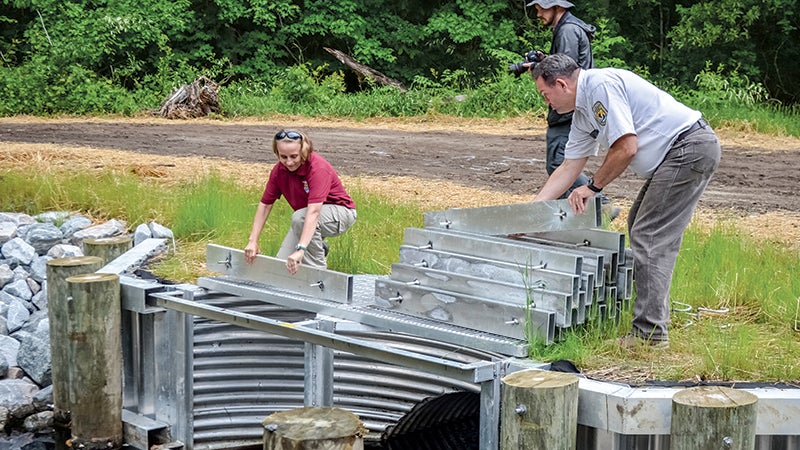Refuge conditions improving
Published 10:30 pm Thursday, May 11, 2017

- U.S. Fish and Wildlife hydrologist technician Karen Balentine and project manager David Byrd demonstrate how to use one of the new water control structures at the Great Dismal Swamp National Wildlife Refuge on Thursday.
A new asset for the Great Dismal Swamp National Wildlife Refuge was demonstrated on Thursday.
The U.S. Fish and Wildlife Service demonstrated one of the new water control structures on the Portsmouth ditch in the refuge during a special event.
The structure is one of 14 across 30,000 acres of the refuge, all designed to lessen flood risk for nearby communities, reduce the dangers of wildfires and improve the habitat for wildlife and vegetation.
These structures are part of a $3.13-million project supported by federal funding to improve resiliency and recovery of the refuge in the wake of Hurricane Sandy.
“Any time money comes to the Dismal Swamp, there’s going to be a good return on that money,” said Brian van Eerden, director of The Nature Conservancy’s Southern Rivers Program.
Construction began in July 2016 and is expected to finish by July 2017, according to U.S. Fish and Wildlife Service project manager David Byrd.
Refuge staff demonstrated how the structures are used to project partners on Thursday. The partners include U.S. Geological Survey, U.S. Army Corps of Engineers, and federal, state and local government officials.
“I think they’re doing great work,” said congressman Donald McEachin, representative from Virginia’s 4th District. “Managing our natural resources is not just the responsible thing to do, but the right thing to do.”
Each structure is made of aluminum and acts as an adjustable dam to regulate the amount of water leaving the swamp. Aluminum boards called “stop logs” are placed in the structure depending on the water level in the ditch.
“We’ll have a target elevation we will want to maintain in the ditch, and we’ll use the boards to maintain that elevation,” said U.S Fish and Wildlife hydrologist Fred Wurster.
These structures will allow the refuge environment to be more resilient to droughts, windstorms, flooding and fire.
Forest fires will be dampened by boarding up the structures and pumping the water for fire suppression crews.
“Once these water structures are in place, it will enable fire suppression crews to more quickly direct water,” Eerden said.
Water levels in the peat soil will rise as the water is kept in the refuge. This will remoisten peat soil and reduce the risk of forest fires.
“We want to keep the water in the ground as close the surface as possible to keep the peat wet,” said U.S. Fish and Wildlife hydrologist technician Karen Balentine.
This control will have an immense impact on refuge wildlife and vegetation. The Great Dismal Swamp was drained over hundreds of years to create dry conditions for loggers, which was detrimental to wetland trees and animals.
Black bears, neotropical migratory birds and woodpeckers will benefit from the improved refuge conditions. As more natural conditions are induced, wetland tree species will be able to thrive in the habitat, officials said.
“It gives wetland tree species, like Atlantic white cedar and bald cypress, a chance to come back in,” Balentine said.
The structures will allow refuge managers to address flood concerns during storms.
“It should reduce smaller storm flood peaks that happen out here,” Wurster said.
United States Fish and Wildlife and the U.S. Geological Survey will continue to collect data using a model designed for system and water management throughout the whole refuge, Byrd said.
“That model is going to allow them to better manage the water system in the refuge,” he said.
The improvements to the Great Dismal Swamp will also reduce smoke exposure for community residents and tourists. There are 1.5 million people within an hour’s drive of the 112,000-acre refuge, according to a press release.
The improvements are expected to draw tourism for hiking, fishing, bird watching and everything else the refuge has to offer.
“This refuge is a celebration of nature, history and American culture,” said Deborah Rocque, deputy regional director for the Northeast region of U.S. Fish and Wildlife service.






